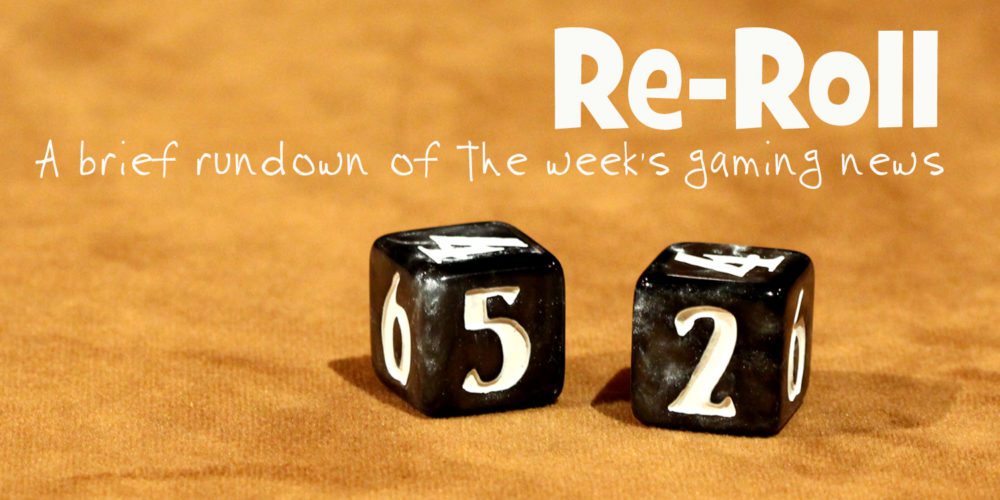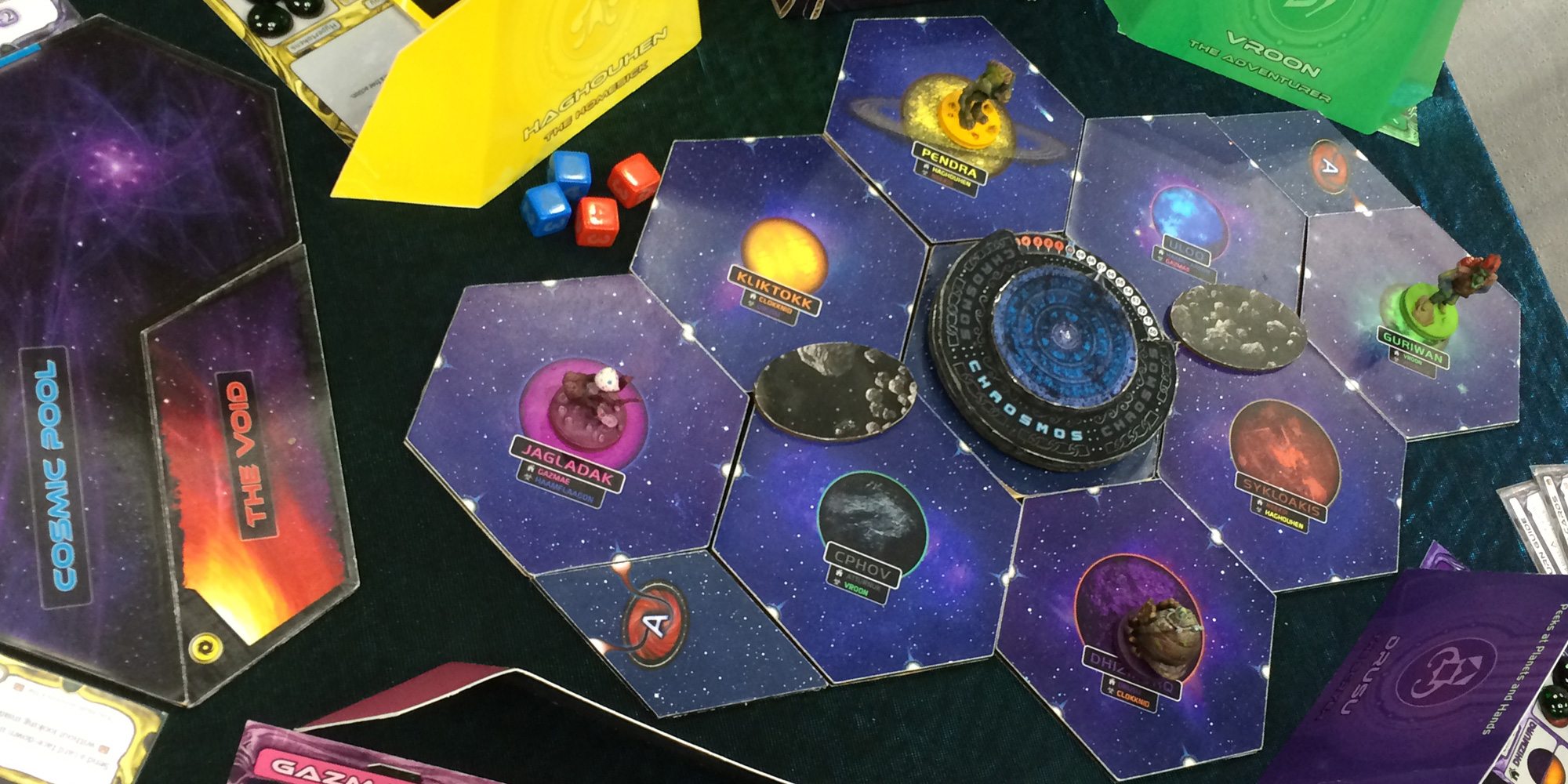Castle Panic game setup: monster tokens, cards, and board showing the monsters and castle. Photo: Jonathan Liu
Overview: In Castle Panic, a lone castle stands in the middle of the forest, which is filled with monsters. You and your friends must work together to defend the castle. One player will earn the title of Master Slayer—but only if you defeat the monsters before the castle towers fall! While Castle Panic isn’t a brand-new game (it was released in 2009) I hadn’t heard of it until recently and Fireside Games was kind enough to send me a review copy when I contacted them about it.
Players: 1 to 6 players
Ages: 10 and up—though since this is a cooperative game, children as young as 6 or 7 could play with some help.
Playing Time: 30-60 minutes (depending on level of difficulty and number of players)
Retail: $35.00
Rating: Excellent—not very deep strategy, but a solid cooperative game that’s easy to pick up and offers several ways to play.
Who Will Like It? If you like co-op games but need something a little lighter than Pandemic or you just want a change of scenery from Forbidden Island, Castle Panic offers a fun monster-slaying alternative. Or if you just like the idea of a little cardboard castle being assaulted by goblins, orcs and trolls, you’ll probably get a kick out of this one.
Theme:
The setting is pretty fun and the theme works well: monsters approach from the forest from all directions—if they get close enough they can tear down walls and eventually attack the towers inside. They can also launch giant boulders from the forest which destroy the first thing they encounter (and also crush monsters who happen to be in the way). There are even a few boss monsters, like the Healer who gives all the damaged monsters some more health, or the Orc Warlord who urges all the monsters to advance an extra rank.
Defending the castle are various warriors: swordsmen, knights and archers all have their specific ranges for attack. Heroes can attack anywhere, and the ferocious barbarian can slay any monster in one fell swoop. You can also use tar to slow the approach of a monster, or fortify your walls to give them an extra point of defense.
My only question is—who built this castle in the middle of enemy territory, anyway? Where’s the road to the rest of civilization?
Components:
Castle Panic comes with a game board, 49 Castle cards, 49 monster tokens, 6 walls and 6 towers with plastic stands, 1 tar token, 2 fortify tokens, a six-sided die and some Order of Play reference cards. All of the tokens are sturdy cardboard and are already punched out. The board is colorful, easily legible and has some reminders printed in the corners for easy reference. The cards are excellent quality, standard-sized. The artwork on the cards and monster tokens are well-done illustrations, with a hint of humor on some. They’re not goofy, but they’re also not scary, so if you decide to play with your younger kids they won’t be traumatized but older players won’t feel like they’re playing a little kids’ game.
Overall, the components are just very nicely done and everything works as intended. The triangular monster tokens are ingenious—they’re designed to fit in each arc going around the castle, and the shape allows you to easily keep track of how many damage points it has remaining. It’s a very clever detail.
Gameplay:
Players start with four to six cards depending on the number of players, and the board starts with six predetermined monsters in the Archer ring of the board. On each turn, a player performs these actions in this order:
- Draw back up to a full hand.
- Discard and draw 1 card if desired.
- Trade cards with other players if desired (one or two depending on number of players).
- Play as many cards as desired.
- Move all monsters one step closer.
- Draw two new monster tokens.
Most of the cards allow you to attack specific zones—for instance, the Green Knight can only attack monsters in that area of the board. There are some “any color” cards which will allow you to target a particular ring but any of the colors, and the Heroes can attack any distance but are limited to a particular color. There are also cards that will allow you to rebuild destroyed walls, push a monster back into the forest, fortify walls, or throw tar on monster.
The monsters move one ring at a time in a straight line—when they reach a wall, they destroy it but lose one hit point. If they’re still alive, then the next turn they destroy a tower (and lose a hit point). Thereafter, they move clockwise within the castle, destroying towers until they run out of hit points or are otherwise slain.
When new monsters are added to the board, the die is rolled to see where they will start. Some of the monster tokens aren’t just monsters, though. There are the boulders and boss monsters, but there are also some tokens which just have specific effects: Plague tokens force you to discard all of a specific type of card—everyone might lose all their knights, for instance. There are also some tokens which make all the monsters in a specific color zone advance a row, or cause all the monsters to move clockwise or counter-clockwise one section, which can really throw off your strategy.
If at any time all six towers are destroyed, the game is over and everyone loses—towers can’t be rebuilt. The game continues until the castle is defeated or until all the monsters have been killed.
Variants
There are actually three main variations for play. In the Standard version, everyone keeps all the monster tokens that they’ve slain, which are worth points if you survive the onslaught. Whoever has the most points at the end is the Monster Slayer. Co-op is exactly the same but all the monsters are discarded when slain, so it’s purely cooperative and the goal is just to survive together. Finally, for those of you who just can’t stand having everyone on the same team, there’s the Overlord version: one player gets to control the monsters! In this case the Overlord gets a hand of monster tokens, and has some choices in how to play them against the other players.
Other than these three variants, you can also play Solitaire (with just a few minor adjustments), and there are plenty of optional rules included to increase (More Panic) or decrease (Less Panic) the difficulty level. When I played with my seven-year-old we used the “Easier Battles” rule to remove some of the more difficult monsters beforehand. Since we won with only two towers missing, we might increase the difficulty next time we play. One of the More Panic rules is “Under Construction,” where you don’t start with any walls at the beginning, just towers. You’ll have to build those walls as you fight off the monsters! And for those who are really against cooperation, you can try “A Man’s Home Is His Castle”—everyone picks a tower at the beginning of the game, and if your tower is destroyed you’re eliminated from the game.
The full rules can be downloaded from the Fireside Games website.
Conclusion:
Castle Panic is a very fun game that allows you a lot of options to change up the gameplay. I like the fact that it’s easy to adjust the difficulty level and even the level of cooperation with a few simple tweaks. The basic rules are simple to learn, and everything from the board to the tokens to the cards are easy to read and understand, which makes teaching the game a snap. It doesn’t require a high level of strategy—there’s a lot of luck involved in the monster draws, card draws and die rolls—but it does give a pretty good feel for the advancing horde of monsters coming out of the forest. Though the suggested age range is ten and up, it could easily be played by younger kids and will still be enjoyed by many adults.
I really enjoyed Castle Panic and I’d recommend it to anyone who would like a fun, not-too-heavy co-op game. It might not become your favorite, but it’s a good one for your collection because of its ability to be adjusted to suit a wide number of players and ranges of difficulty.
Wired: Overall, a really solid concept that’s well-executed and free of annoying glitches. Extremely versatile game.
Tired: My six-sided die seemed to just roll 4s during the game—but when I subjected it to a 100-roll examination it seemed to behave.
Disclosure: GeekDad received a review copy of this game.






